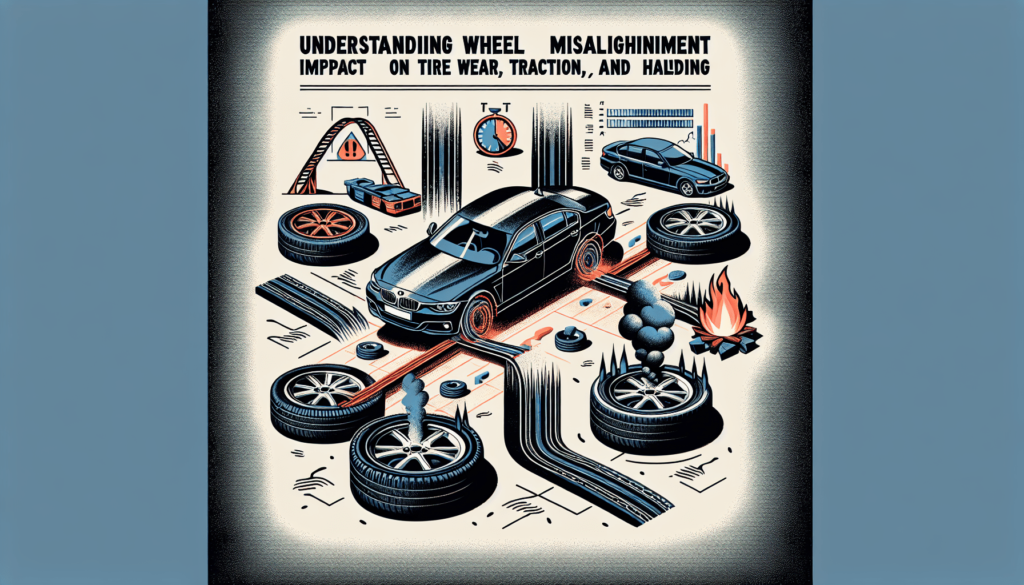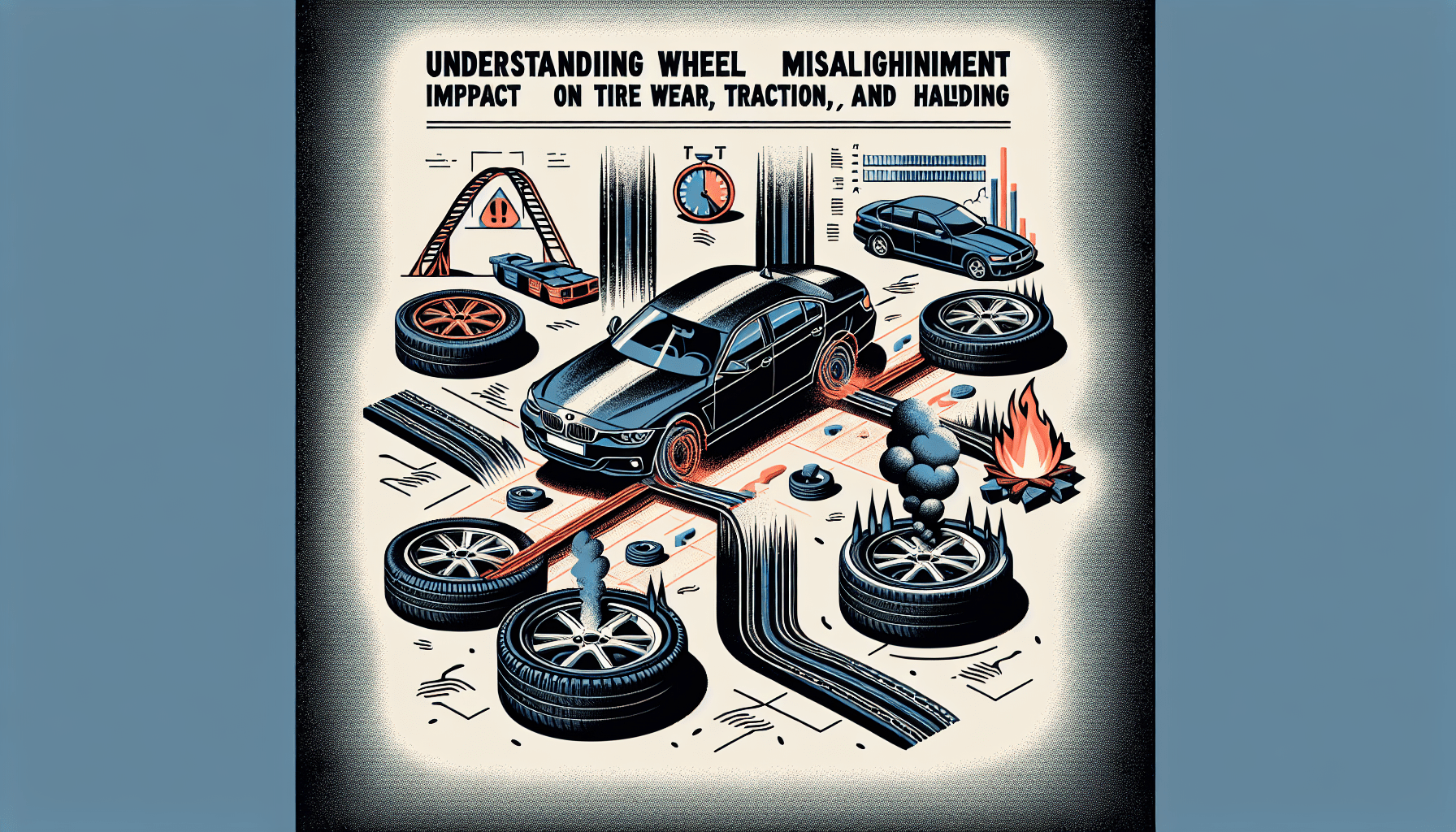Have you ever wondered how misaligned wheels can impact the performance of your tires? When your wheels are not properly aligned, it can lead to a variety of negative effects on your tires. From increased wear and tear to reduced fuel efficiency, misalignment can cause significant issues. In this article, we will explore the various effects that misaligned wheels can have on tire performance, helping you understand the importance of regular alignment checks and maintenance for a smoother and more efficient ride.

Uneven Tire Wear
Inner Edge Wear
When your wheels are misaligned, it can cause your tires to wear unevenly. Inner edge wear, in particular, is one of the common consequences of misalignment. This occurs when the inner edges of your tires experience excessive wear and tear. The misalignment puts extra stress on these areas, causing the tires to wear down faster than usual. Not only does this result in the need for more frequent tire replacements, but it can also compromise the overall performance and safety of your vehicle.
Outer Edge Wear
On the opposite end of the spectrum, misaligned wheels can also lead to outer edge wear. This occurs when the outer edges of your tires wear down faster than the rest of the tread. When your wheels are not properly aligned, it can cause the tires to tilt outward or inward, putting more pressure on the outer edges. As a result, these areas of the tires wear down quicker, leading to the need for premature tire replacements. Outer edge wear can also negatively impact your vehicle’s stability, handling, and fuel efficiency.
Center Wear
Another indicator of misaligned wheels is center wear on your tires. Center wear refers to the excessive wearing of the center portion of the tire tread. When your wheels are misaligned, the tires can develop a sagging or concave shape, causing more pressure to be exerted on the center portion. This uneven distribution of weight leads to accelerated wear in the middle, resulting in reduced tire lifespan. It is important to address misalignment issues promptly to prevent further damage to your tires and maintain optimal performance.
Decreased Tire Lifespan
Increased Wear and Tear
Misaligned wheels can greatly increase the wear and tear on your tires. As mentioned earlier, misalignment causes certain areas of the tires to experience more pressure and friction than others. This uneven distribution of forces leads to accelerated wear and tear on the tire tread. With each rotation, the misaligned wheels put unnecessary strain on specific parts of the tires, causing them to deteriorate at a faster rate. This premature wear greatly reduces the lifespan of your tires and increases the frequency at which they need to be replaced.
Reduced Mileage
In addition to increased wear and tear, misaligned wheels can also result in reduced mileage. When your wheels are not properly aligned, they create unnecessary drag and resistance against the road. This increased rolling resistance makes it more difficult for your vehicle to move forward, requiring more energy and fuel to maintain speed and travel the same distance. As a result, you may notice a decrease in your vehicle’s overall fuel efficiency, as well as reduced mileage. This not only adds an additional cost to your pocket but also negatively impacts the environment.
Reduced Handling and Stability
Sensitivity to Road Irregularities
Misaligned wheels can greatly affect your vehicle’s handling and stability. When your wheels are not aligned correctly, each tire may respond differently to road irregularities such as potholes, bumps, or uneven surfaces. This can make your vehicle feel less stable and cause it to veer or pull in certain directions. The misalignment can also amplify the vibrations and impacts experienced by your tires, resulting in a more uncomfortable ride. Additionally, the sensitivity to road irregularities can make it more difficult for you to maintain control of your vehicle, especially in critical situations.
Poor Cornering
Misaligned wheels can also have a negative impact on your vehicle’s cornering capability. When your wheels are not aligned properly, it can affect how your vehicle responds when making turns or maneuvering curves. Misalignment can cause uneven weight distribution on the tires, making it harder for them to maintain proper grip on the road during cornering. This can result in poor handling and compromised stability, leading to a potential loss of control. Proper wheel alignment is crucial for maintaining safe and precise cornering, so it’s important to address any misalignment issues promptly.
Negative Impact on Fuel Efficiency
Increased Rolling Resistance
One of the negative effects of misaligned wheels is increased rolling resistance. When your wheels are not aligned properly, they create unnecessary friction and resistance against the road surface. This means that your vehicle needs to work harder to overcome this resistance and maintain forward motion. The increased rolling resistance requires more power and energy, ultimately resulting in higher fuel consumption. Misaligned wheels can significantly reduce your vehicle’s fuel efficiency, causing you to spend more money on gas and increasing your carbon footprint.
Higher Fuel Consumption
As a direct consequence of increased rolling resistance, misaligned wheels can lead to higher fuel consumption. When your vehicle needs to exert more effort to overcome the resistance caused by misalignment, it requires more fuel to sustain movement. This means that you will need to visit the gas station more frequently and spend more money on fuel. In addition to the financial implications, the additional fuel consumption also contributes to environmental pollution. By maintaining proper wheel alignment, you can ensure optimal fuel efficiency and reduce your vehicle’s impact on the environment.

Increased Risk of Tire Blowouts
Overheating and Tire Degradation
Misaligned wheels can increase the risk of tire blowouts due to overheating and degradation. When your wheels are not properly aligned, it can cause certain areas of the tires to bear excessive weight and friction. This constant stress and friction can generate excessive heat, leading to tire degradation and weakening of the tire structure. Over time, the continuous overheating and degradation can result in a tire blowout, which can be extremely dangerous, especially at high speeds. Proper alignment helps distribute the weight evenly across all tires, reducing the risk of overheating and tire blowouts.
Loss of Control
In addition to the potential for tire blowouts, misaligned wheels can also lead to a loss of control over your vehicle. When your wheels are not aligned properly, it can cause your vehicle to pull to one side or the other. This constant pulling can make it difficult for you to maintain a straight path, especially on highways or at higher speeds. The loss of control can create hazardous driving situations and increase the risk of accidents. By addressing wheel misalignment, you can ensure that your vehicle maintains proper stability and steering control, enhancing overall safety on the road.
Alignment-related Suspension Problems
Uneven Suspension Wear
Misaligned wheels can have detrimental effects on your vehicle’s suspension system. When your wheels are not aligned properly, it can result in uneven distribution of weight and forces among the suspension components. This uneven wear can lead to the premature deterioration of various suspension parts, such as control arms, bushings, and ball joints. Over time, the misalignment-related suspension problems can become costly to repair and compromise the overall performance and safety of your vehicle. Regular wheel alignments can help prevent these issues and prolong the lifespan of your suspension components.
Damaged Shock Absorbers
Another alignment-related suspension problem is the damage to the shock absorbers. When your wheels are misaligned, it can cause the shock absorbers to work harder than necessary. They will have to compensate for the uneven weight distribution and absorb more impacts and vibrations. This increased workload can put a strain on the shock absorbers, causing them to wear out faster. Damaged shock absorbers can negatively affect your vehicle’s ride quality, handling, and overall comfort. By maintaining proper wheel alignment, you can preserve the condition of your shock absorbers and ensure a smoother driving experience.

Higher Maintenance Costs
Excessive Tire Replacement
Misaligned wheels can lead to excessive tire replacements, resulting in higher maintenance costs. When your wheels are not aligned properly, it causes certain areas of the tires to wear down unevenly and at a faster rate. This accelerated wear and tear can significantly reduce the lifespan of your tires, requiring you to replace them more frequently. With each tire replacement comes additional expenses, including the cost of new tires, mounting, and balancing. By addressing wheel misalignment, you can extend the lifespan of your tires and save money in the long run.
Frequent Alignment Adjustments
In addition to the increased tire replacement costs, misaligned wheels also necessitate more frequent alignment adjustments. When your wheels are not properly aligned, it is important to have them realigned to prevent further damage and ensure optimal performance. However, frequent alignment adjustments can add up in terms of costs and inconvenience. Regular wheel alignments can help detect and correct misalignment issues early on, reducing the need for frequent adjustments. By investing in periodic alignment checks, you can avoid unnecessary expenses and keep your vehicle running smoothly.
Influence on Vehicle Safety
Compromised Braking Performance
Misaligned wheels can compromise the braking performance of your vehicle. When your wheels are not aligned properly, the uneven weight distribution can affect the braking force exerted by each tire. This can result in uneven braking and reduced stopping power, potentially increasing your stopping distance. The compromised braking performance can pose a hazard, especially in emergency situations where quick and precise stopping is crucial. Proper wheel alignment ensures that all tires contribute evenly to the braking force, enhancing the safety of your vehicle and everyone on the road.
Difficulty Maintaining Proper Steering
Another safety concern associated with misaligned wheels is the difficulty in maintaining proper steering control. When your wheels are not aligned correctly, it can cause your vehicle to pull to one side or the other. This constant pulling puts strain on your steering system, making it challenging for you to steer in a straight line. This difficulty in maintaining proper steering control can lead to erratic driving behavior and increase the risk of accidents. By addressing wheel misalignment, you can ensure that your steering remains smooth and responsive, promoting safe and predictable driving.

Effects on Comfort and Ride Quality
Increased Vibration and Noise
Misaligned wheels can significantly increase the level of vibration and noise experienced inside the vehicle. When your wheels are not properly aligned, it can cause tires to generate excessive vibrations as they roll along the road surface. These vibrations can be transmitted throughout the vehicle, resulting in a rough and uncomfortable ride. Additionally, misalignment can cause tires to wear down unevenly, leading to irregular tread patterns that can generate additional noise. By maintaining proper wheel alignment, you can minimize vibrations and noise, ensuring a smoother and quieter ride for you and your passengers.
Overall Discomfort
In addition to increased vibrations and noise, misaligned wheels can also cause overall discomfort during your driving experience. The uneven wear on tires can result in an imbalance in the way your vehicle rides and handles. This can lead to a bumpy and jarring sensation, making it challenging to enjoy a comfortable journey. Whether you’re commuting or embarking on a long road trip, the discomfort caused by misalignment can take away from the pleasure of driving. Regular wheel alignments help promote a balanced and comfortable ride, enhancing your overall driving experience.
Impact on Overall Vehicle Performance
Impaired Acceleration
Misaligned wheels can impair the acceleration capabilities of your vehicle. When your wheels are not aligned properly, it can create an imbalanced distribution of forces and resistance. This imbalance affects the way your tires grip the road, resulting in reduced traction and compromised acceleration. As a result, your vehicle may struggle to accelerate as efficiently as it should, impacting its overall performance. Proper wheel alignment ensures optimal tire contact with the road, maximizing traction and enhancing acceleration capabilities.
Diminished Handling Response
Another aspect of overall vehicle performance impacted by misaligned wheels is the handling response. When your wheels are not properly aligned, it can affect the stability and responsiveness of your vehicle’s steering. The misalignment can cause your vehicle to veer or pull in certain directions, making it more difficult to navigate curves or maintain a straight line. The diminished handling response can compromise your ability to control your vehicle effectively, especially during sudden maneuvers or emergency situations. By addressing wheel misalignment, you can restore optimal handling response and enhance the overall performance of your vehicle.
In conclusion, misaligned wheels can have a significant impact on multiple aspects of tire performance and overall vehicle functionality. From uneven tire wear and decreased lifespan to reduced handling and loss of control, the consequences of wheel misalignment are far-reaching. Additionally, misalignment negatively affects fuel efficiency, increases the risk of tire blowouts, and leads to alignment-related suspension problems and higher maintenance costs. Furthermore, misaligned wheels compromise vehicle safety, comfort, and ride quality while impairing overall performance. Regular wheel alignments are essential for maintaining optimal performance, preserving tire lifespan, and ensuring a safe and enjoyable driving experience.


